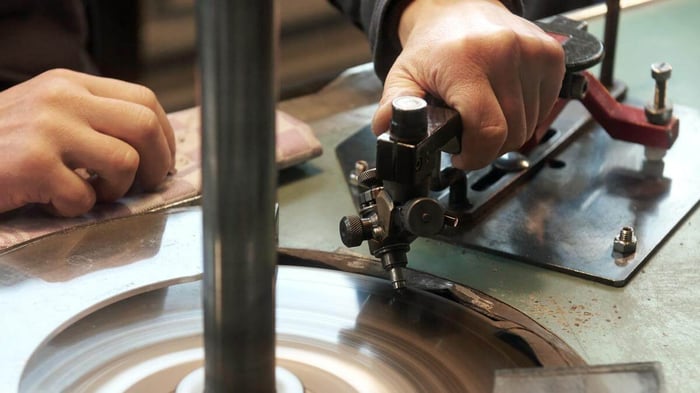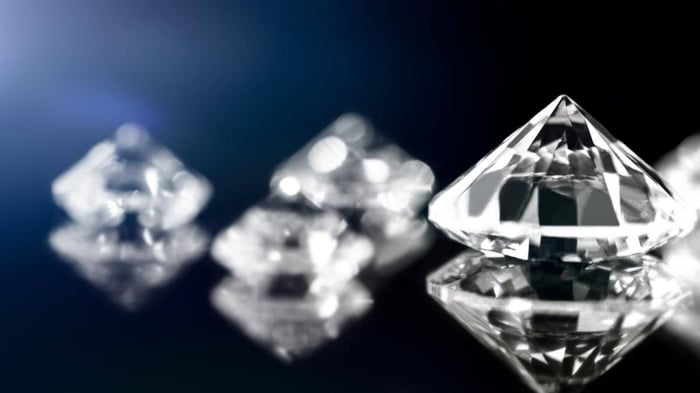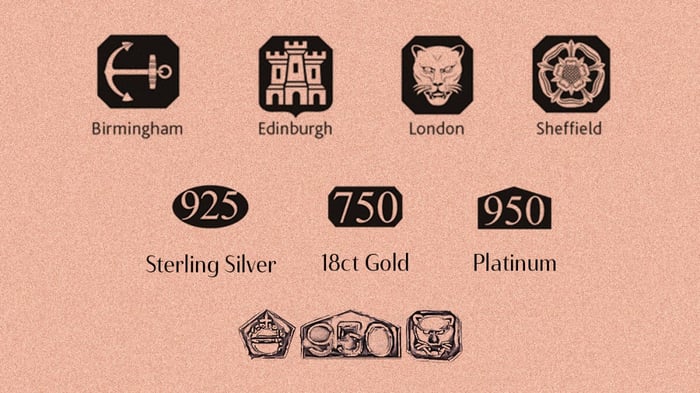The Secrets Behind How Diamonds Are Cut
When you know how diamonds are cut you will be able to understand what goes into making rough white stones into beautiful diamonds and appreciate the artistry and skill that makes diamond jewellery possible. Please reason to find out more.
As you probably already know, already, diamonds are classified according to the 4Cs, clarity, colour, cut and carat weight.
In diamond jewellery, the diamond cut is the characteristic considered to be the most important. The diamonds cut is not about the shape of the diamond itself but the quality of the workmanship that goes into creating the gems on your engagement ring, diamond earrings or necklaces.
A diamond cut to a high standard can, through the placement of the facets and polishing quality, offset a relatively low clarity grade or conceal slight discolourations.
However, a poorly cut but otherwise flawless diamond with no discolouration (A diamond with a D colour grade), internally flawless, diamond with no inclusions, will look less good than a perfectly cut, lower grade diamond.
It is the quality of the diamond’s cut that releases all a diamond’s sparkle and fire. For this reason, when buying a diamond or piece of diamond jewellery, consider the cutting grade and notes on the diamond’s grading certification. For many experts, the cut of the diamond is the most important single aspect of a diamond’s overall quality!
A (Very) Brief History Of Diamond Cutting
Diamond cutting, in a very crude form, began in the mid-14th century. At that time, the process was little more than a superficial polishing of the stone to give it a degree of shine. Back then, diamonds were very rare, such that only royalty could afford to own them. The earliest cuts of diamonds were simple flat and step cuts followed by point cuts that lead to the classic diamond shape seen in illustrations for hundreds of years.
£601.00
Simple, elegant and classic. This quarter carat, diamond cross pendant is a timeless piece that will mix and match with any outfits and jewellery you already own; freshening up your entire wardrobe. We're proud to offer light, breezy, and fantastic… read more0.25ct Classic Claw Set Diamond Cross Pendant in 18K White Gold
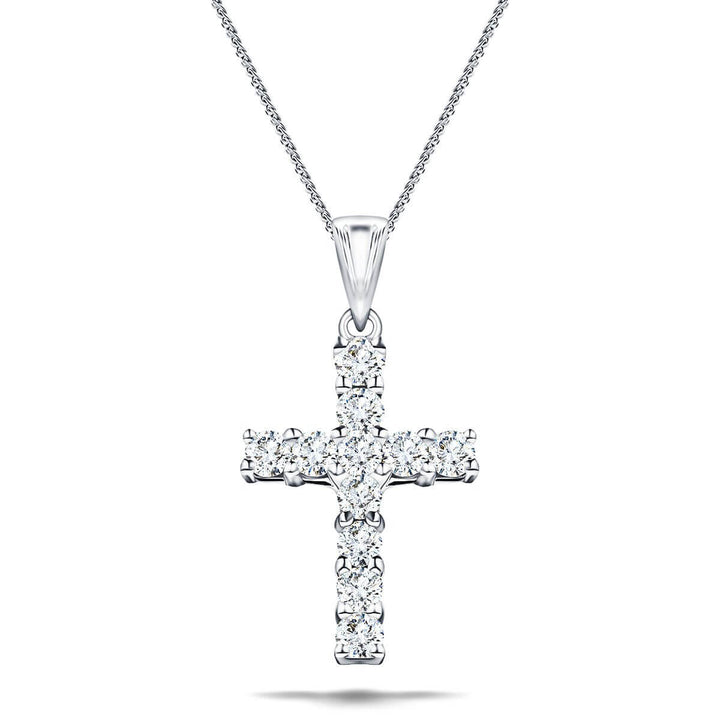
£817.00
During the 17th century, jewellers discovered that cutting facets (flat surfaces at specific angles to each other) could give the diamond the ability to trap and reflect light and thus sparkle, giving diamonds brilliance that had never been seen before. The development of tools to cut with the precision needed to cut facets into diamonds led to the tools and techniques used by diamond cutters ever since to create the variety of diamond shapes we have today.
Originally, diamond cutting was done with saws and rotating wheels, each with diamond fragments to enable the cutting of the diamond to take place. Today, diamond cutters typically use lasers as they much faster, more consistent and efficient.
The original flat or table cuts led to complex shapes such as the brilliant cut that is the most popular modern cut.
How Are Diamonds Cut?
Diamond cutting has five distinct steps. The process of cutting and polishing a rough, dull diamond into the brilliant, shining objects of desire in our jewellery is a lengthy, highly skilled and intensive process.
Knowing what goes into transforming a rough diamond into diamond jewellery helps us appreciate the work done and the value of the finished object.
Rough Stone Shapes
The natural shape and size of the original rough diamond set the shape and size of the finished diamond as it is ready to be mounted into diamond jewellery. For example, rectangular stones will be shaped into ovals, marquises or pear shapes, and rounder diamonds will be cut into round shapes such as the round brilliant.
£1,928.00
Our classy three stones bezel set ring is impeccably designed, showcasing three breath-taking round brilliant cut and ethically sourced G/SI quality diamonds in a bezel setting placed in the middle of a shining 18k yellow gold band. A simple and… read more18k Yellow Gold 0.75ct G/SI Diamond Three Stone Bezel Set Ring
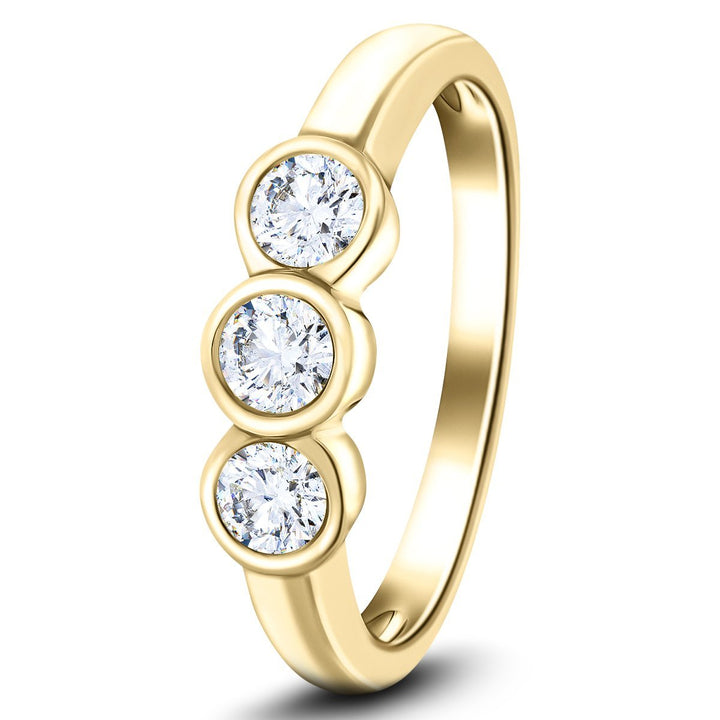
£3,447.00
If a rough diamond retains its perfect crystal shape, it will be turned into a princess cut or another square cut. Planning the cut can take some time because the planner and cutter will want to minimise wastage.
Some rough diamonds may be cut into more than one finished gem.
Planning The Cut
The first step that the diamond takes in the cutting workshop is planning the cut. The planner has the sole job of deciding where to mark the stone for cutting to maximise the value and beauty of the diamond with as little wastage as possible. Sometimes this can lead to a compromise where, due to internal flaws, a diamond will be cut into a less than optimal shape to avoid a visible internal flaw (inclusion) in the finished product.
Mistakes made at the planning stage can cost thousands of pounds on a large stone. The planner must consider how to get the most out of a rough diamond. He needs to be aware of the crystal structure when he marks the positions where cleaving (splitting) the diamond will be done. If he gets this wrong, the diamond can shatter into a myriad of worthless shards.
Diamond Cleaving Or Sawing
Following the markings on the rough diamond, the cutter will either manually split (cleave) or saw the diamond into the approximate shape of the finished gem. These days, lasers are increasingly used for their speed and reduction in the chances for damage caused by impact during the cleaving stage. Some cutters still use the diamond-coated rotary saws that have been used in a similar form for hundreds of years.
Bruting A Diamond
Bruting is the process where the worked-on diamond is spun on a rotating lathe, and another diamond is forced against it to form a rounded girdle around the diamond. The girdle is the widest point on a diamond. As with diamond cutting, the older mechanical tools are being replaced by lasers which can work very precisely and fast.
Diamond Polishing
Polishing is the final part of the diamond cutting process. Here the diamond takes on its final proportions.
The first polishing stage is blocking. Blocking establishes the diamond’s symmetry; the first 17 or 18 facets are created at this stage. For small diamonds, the process ends here. Smaller diamonds do not benefit from a high degree of polishing or faceting, and so, they are ready for setting into the precious metal of the final piece of jewellery.
Brillianteering
Brillianteering is the final stage in the polishing process. Here, in larger diamonds, the final facets of the finished diamond are created. A skilled diamond cutter will release all the fire and sparkle of which the diamond is capable at this stage. On the other hand, if a poor job is done, the diamond will appear dull or lifeless with imperfect symmetry.
For the diamond cutter, the driving force is to create a diamond jewellery masterpiece. Of course, as we mentioned earlier, sometimes, a diamond cutter will compromise the quality of the cut to save a badly flawed diamond or reduce wastage.
£5,303.00
This full eternity ring features nineteen gorgeous and ethically sourced G/SI quality diamonds weighing a total of 3.00ct, which are held in classic claw settings and showcased around a pristine, UK hallmarked, 18K white gold band. This beautiful ring's outstanding… read more19 Stone Full Eternity Ring 3.00ct G/SI Diamonds In 18k White Gold
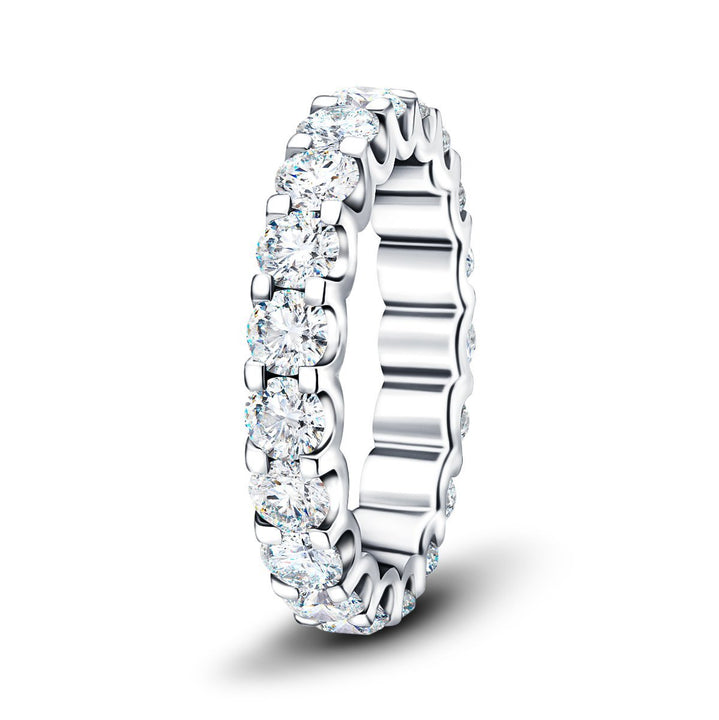
£9,967.00
Now that you know the answer to the question. how are diamonds cut, you will be able to make better diamond jewellery buying decisions. Sometimes, you will be able to spot a poorly cut diamond from its lack of sparkle, but in the bright lights of a jeweller’s display, this can be hard. That is why you should insist upon a diamond grading certificate when you buy diamond jewellery. The central diamond needs a certificate to show that you are purchasing the best quality you can afford and not being fobbed off with low-quality diamonds or workmanship. At All Diamond, all our jewellery is hand made and finished. We work with the GIA, the most trusted provider of diamond grading certification, so that you can be sure that your diamond jewellery is of high quality and great value.
